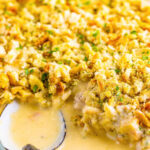Pioneer women, those intrepid figures who ventured westward across America, often evoke images of resilience and self-sufficiency. While their spirit is well-documented, their clothing, a crucial aspect of their daily lives, is often romanticized or simplified. As someone fascinated by the Victorian era and with roots in the American Southwest, I’ve been exploring the realities of pioneer women’s wardrobes, seeking to understand how their clothing differed from their Eastern counterparts and what practical considerations shaped their style. This exploration reveals a fascinating intersection of necessity, modesty, and enduring feminine ideals.
For this discussion, “frontier” refers to the regions west of Missouri and Arkansas, roughly spanning the period from 1850 to 1890. We’ll focus on the clothing of women homesteaders and those in settlement communities, primarily white settlers migrating from the East. It’s important to remember that clothing for these women was less about ostentatious display and more about practicality and shared identity as they pursued dreams of a new life in the West.
The Foundation: Undergarments
Surprisingly, the underpinnings of pioneer women’s fashion weren’t drastically different from those worn in Eastern cities. The chemise, a simple, lightweight cotton slip, remained the essential base layer, prioritized for hygiene and frequent washing. Pantalets, made of flannel or cotton, were added for modesty, serving a similar purpose to modern underwear which was not yet common.
Contrary to some assumptions of a completely utilitarian frontier wardrobe, corsets were a standard item for most pioneer women. These women, driven by aspirations for a better future, whether economic or religious, often maintained a sense of “propriety” and social standards from their former lives. The corset was seen as fundamental to maintaining this image.
While the rigors of frontier life might have led some women to loosen or occasionally forgo their corsets during strenuous housework, it was generally retained as a key garment. Petticoats, another familiar Victorian undergarment, followed the corset. Pioneer women often possessed multiple petticoats, varying in weight and material to suit different occasions and weather conditions. Stockings were essential for venturing outside or receiving guests, typically secured with garters or tucked into pantalets – a somewhat cumbersome but common practice.
Fabrics of the Frontier: Practicality and Availability
Calico emerged as the dominant fabric for pioneer clothing. Often mistaken for just floral prints, calico is actually a type of plain-woven cotton fabric, slightly lighter than canvas and made from unprocessed cotton. Its attributes – lightweight, durable, and easy to clean – made it ideal for the demands of frontier life. While general stores offered some dyed calico, women frequently dyed fabrics themselves using commercially available dyes or natural pigments derived from local plants like leaves, bark, berries, and fruits.
 Pioneer woman in calico dress and apron, embodying daily life on the Western frontier.
Pioneer woman in calico dress and apron, embodying daily life on the Western frontier.
Cotton and silk fabrics were still valued for “Sunday best” attire and more formal dresses. Many women brought a few finer outfits with them from the East. Fabric availability depended heavily on access to general stores, which varied greatly across the frontier. In more isolated areas, families often relied on homespun fabrics, a craft that deserves its own dedicated exploration.
Daily Dress: Adapting to Frontier Life
Regardless of their backgrounds, women on the frontier were integral to establishing and maintaining homes and farms. Daily life involved relentless physical labor: cooking, cleaning, childcare, laundry, and often fieldwork. Success depended on everyone’s contribution, with no room for outsourcing domestic tasks. Frontier women quickly adapted to a life of manual labor, and their clothing reflected this reality.
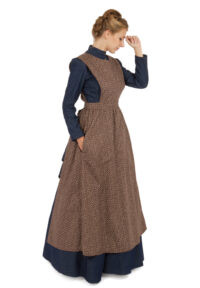 Close-up of a pioneer calico apron, showcasing its practical design and durable fabric.
Close-up of a pioneer calico apron, showcasing its practical design and durable fabric.
The prevailing fashion silhouette of fitted bodices and full skirts remained, but practical modifications were essential. Daily wear skirts were hemmed approximately three inches shorter than fashionable Eastern styles to facilitate movement. Hems might also be weighted to prevent them from blowing up in the wind, a common frontier challenge. Bodices remained fitted, but sleeves were loosened and extended to the wrists, paired with high collars for sun protection.
Laundering clothing was a significant undertaking. “Wash dresses” became popular for their easy care. As described in Chris Enss’s book How the West Was Worn, these were often two-piece dresses of white cotton with printed patterns, readily available in stores and copied by seamstresses. Their washability made them practical for women across socioeconomic levels. This “wash dress” exemplifies how fashion adapted to the specific needs of frontier living.
Sunday Best: Maintaining Tradition
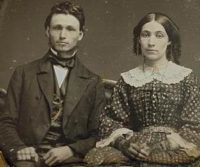 Pioneer couple dressed in their Sunday best, showcasing the blend of frontier practicality and Eastern fashion influences.
Pioneer couple dressed in their Sunday best, showcasing the blend of frontier practicality and Eastern fashion influences.
Even in sparsely populated areas, settlements often established churches, and church attendance was a strong community norm. While accounts exist of women in impoverished communities attending church barefoot, it was more common for women to reserve one or two dresses specifically for Sundays. However, historical records often lean towards documenting more privileged settlers, making it difficult to definitively ascertain the most widespread reality.
Frontier “Sunday best” closely mirrored contemporary fashions in Eastern cities. Full skirts, worn over petticoats and corsets, were standard. Sleeve styles, like bell, leg-o-mutton, or pagoda sleeves, reflected current trends. Skirt styles, whether crinoline, hoop, or bustle, also followed the fashionable dictates of the time, depending on the decade. Younger and newly married women favored lighter colors, transitioning to darker hues as they aged. Sunday outfits were completed with fashionable hats, kid gloves, and low-heeled boots.
Social Occasions: Dressing for Community
When circumstances allowed, pioneer women would have a separate dress reserved for social events beyond church. Dances, holiday celebrations, picnics, and other community gatherings were vital social outlets. Just as in Eastern cities, women dressed for these occasions.
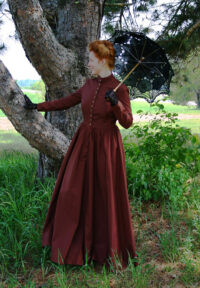 Woman in a formal pioneer dress suitable for church or social gatherings, highlighting the elegance maintained even on the frontier.
Woman in a formal pioneer dress suitable for church or social gatherings, highlighting the elegance maintained even on the frontier.
These dresses were highly prized. Women might order fabrics from general stores and eagerly anticipate creating the latest styles. Godey’s Lady’s Book, a popular magazine, was widely circulated and its fashion plates were enthusiastically copied for dress patterns and style inspiration.
Fabric availability for these special dresses depended on the proximity and stock of general stores. In more remote areas, women might not have had a wide selection of dresses. In such cases, their best dress would be adapted for special events with added embellishments like hand-crocheted collars and shawls, and other accessories.
Accessories: The Finishing Touches
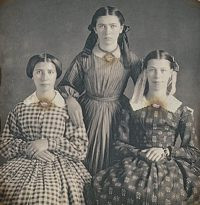 Group of pioneer girls with bonnets and aprons, illustrating the importance of accessories in frontier women's attire.
Group of pioneer girls with bonnets and aprons, illustrating the importance of accessories in frontier women's attire.
Accessories played a surprisingly significant role in pioneer women’s wardrobes. Beyond basic garments, accessories were crucial for adding personal style and refinement. Pioneer women utilized a range of accessories, including:
- Aprons
- Boots
- Brooches
- Lockets
- Earrings
- Precious stones and metals (when available)
- Hair adornments
- Hats
- Collars and cuffs
- Gloves
- Undersleeves
- Parasols
- Fans
- Handbags
- Shawls
Enduring Legacy
Exploring pioneer women’s clothing reveals their resourcefulness and adaptability. Despite the hardships of frontier life, they maintained a connection to fashion and social norms while pragmatically adjusting their wardrobes to meet daily demands. The enduring popularity of “prairie style” and “western wear” today demonstrates the lasting fascination with this era. However, understanding the historical realities behind pioneer women’s clothing provides a richer appreciation for their lives and the practical elegance they cultivated in challenging circumstances. The blend of necessity and a desire for beauty shaped a unique and compelling chapter in fashion history.
Embody the Pioneer Spirit:
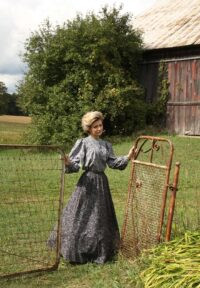 Woman modeling pioneer clothing, showcasing a long-sleeved blue blouse and skirt, ideal for a modern pioneer-inspired look.
Woman modeling pioneer clothing, showcasing a long-sleeved blue blouse and skirt, ideal for a modern pioneer-inspired look.
Discover our Pioneer Clothing Collection
Explore Pioneer Blouses and Skirts
View the Harper Victorian Pioneer Dress
Shop Pioneer Blouse, Apron, and Skirt Sets


